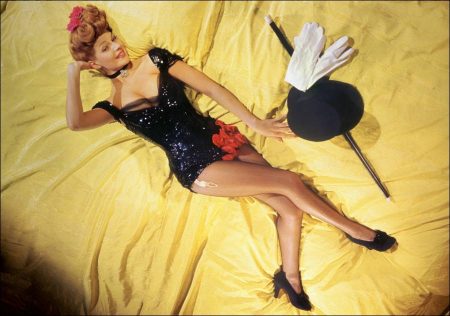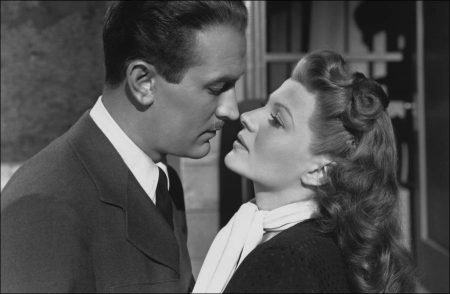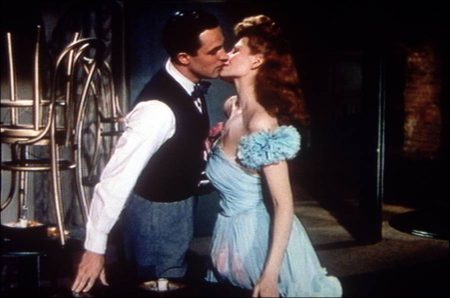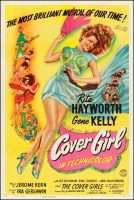Cover Girl movie storyline. Rusty Parker (Rita Hayworth), a red-headed leggy dancer at Danny McGuire’s Night Club in Brooklyn, wants to be a successful Broadway star. She enters a contest to be a ‘Cover Girl’ as a stepping-stone in her career. She reminds the publisher, John Coudair, of his lost love, showgirl Maribelle Hicks (Leslie Brooks). He was engaged to Maribelle, although his wealthy society mother made fun of her. Maribelle left John at the altar when she saw the piano at her wedding. It reminded her of the piano-player she truly loved.
Rusty is Maribelle’s granddaughter and there are musical sequences with Maribelle dancing to songs from the beginning of the 20th century. Rusty lands on the cover of her grandmother’s former fiancé’s magazine (as a bride). She is pursued by Coudair’s pal, the wealthy theatrical producer, Noel Wheaton. He produces a lavish musical to star Rusty, surrounded by real cover girls of the mid 1940’s. Rusty runs down a huge spiral into the arms of dozens of men who seem clumsy next to her ethereal dancing. But her success threatens Danny McGuire.

He expressed his distress that his girlfriend will find success without him in Kelly’s famous dance with himself, ‘Alter Ego’. He and his sidekick, Genius, leave New York and entertain soldiers fighting in World War II. Rusty agrees to marry Noel, dazzled by success, security, and his power and money. But she drinks and loses weight because her heart belongs to Danny. She receives a symbolic pearl with great power and tells Coudair and Wheaton that she must spend her life with the man she loves.
Cover Girl is a 1944 American comedy musical film starring Rita Hayworth and Gene Kelly. The film tells the story of a chorus girl given a chance at stardom when she is offered an opportunity to be a highly paid cover girl. The film was directed by Charles Vidor, and was one of the most popular musicals of the war years. Primarily a showcase for Rita Hayworth, the film has lavish modern and 1890s costumes, eight dance routines for Hayworth, and songs by Jerome Kern and Ira Gershwin, including the classic “Long Ago (and Far Away)”.
About the Production
Columbia Pictures originally wanted to use Warner Bros. star Dennis Morgan for Cover Girl, but when Kelly’s project at MGM, Dragon Seed, was postponed, MGM extended their loan of Kelly to Columbia, allowing this film to be made with him. Columbia’s production head, Harry Cohn, was initially opposed to having Kelly do the film, but producer Schwartz nevertheless obtained him, promising Kelly that he would be able to choreograph, which MGM had not allowed him to do.
Columbia gave Kelly almost complete control over the making of this film, and many of his ideas contributed to its lasting success. He removed several of the soundstage walls so that he, Hayworth, and Silvers could dance along an entire street in one take. He also used trick photography so that he could dance with his own reflection in the sequence “Alter-Ego Dance”, achieved using superimposition to give his “double” a ghost-like quality. Kelly, along with Stanley Donen, devised the choreography. Film historians consider Cover Girl the point where Kelly hit his stride in a musical role that foreshadowed the best of his future work. The film was Hayworth’s fourth musical: the first two she had done opposite Fred Astaire. Hayworth’s singing voice was dubbed by Martha Mears.
Cover Girl was Columbia’s first Technicolor musical, and songwriter Arthur Schwartz’s first venture into producing. The film was a big hit, and made stars out of both Hayworth and Kelly. The success of Cover Girl caused MGM to pay closer attention to Kelly as a viable property, and they allowed him to create his own dance numbers for his next film, Anchors Aweigh (1945), also starring Frank Sinatra. Columbia bought the film rights to Pal Joey, which Kelly had done on Broadway, hoping to pair up Kelly and Hayworth again, but MGM refused to loan him out, and instead the film was made with Sinatra playing the lead.
Awards and Honors
Carmen Dragon and Morris Stoloff won the 1944 Academy Award for Best Music, Scoring of a Musical Picture.
The following were nominated, but did not win:
Lionel Banks, Cary Odell and Fay Babcock for Best Art Direction
Rudolph Maté and Allen M. Davey for Best Cinematography
Jerome Kern (music) and Ira Gershwin (lyrics) for Best Original Song for “Long Ago (and Far Away)”
John P. Livadary for Best Sound, Recording.
The song “Long Ago (and Far Away)” was also ranked 92nd on the American Film Institute’s 2004 list AFI’s 100 Years… 100 Songs.
Cover Girl (1944)
Directed by: Charles Vidor
Starring: Rita Hayworth, Gene Kelly, Lee Bowman, Phil Silvers, Jinx Falkenburg, Leslie Brooks, Eve Arden, Otto Kruger, Jess Barker, John Coudair, Anita Colby, Jean Colleran, Helen Mueller
Screenplay by: Marion Parsonnet (adaptation), Paul Gangelin (adaptation)
Production Design by:
Cinematography by: Allen M. Davey, Rudolph Maté
Film Editing by: Viola Lawrence
Costume Design by: Travis Banton, Muriel King, Gwen Wakeling
Set Decoration by: Fay Babcock
Art Direction by: Lionel Banks, Cary Odell
Music by: Jerome Kern
MPAA Rating: None.
Distributed by: Columbia Pictures
Release Date: March 20, 1944
Visits: 79


